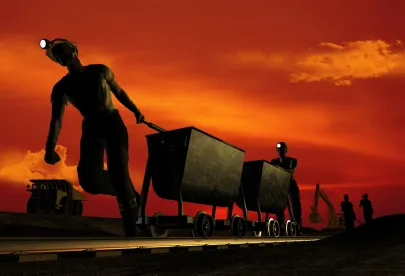On March 12, 2019, a three-judge panel of the U.S. Court of Appeals for the District of Columbia Circuit heard oral argument in United Steel, Paper and Forestry, Rubber, Manufacturing, Energy, Allied Industrial and Service Workers International Union v. Mine Safety and Health Administration, USCA Case No. 18-1116.
The case involves whether the Mine Safety and Health Administration (MSHA), subsequent to the change in presidential administrations in January of 2017, improperly made two substantive changes to the recently promulgated Examinations of Working Places in Metal and Nonmetal Mines regulation. Counsel for the petitioners, representing union miners and steelworkers, argued that MSHA had amended the regulation in violation of (1) the Administrative Procedure Act’s (APA) requirement of “reasoned decision-making” and (2) Section 101(a)(9) of the Federal Mine Safety and Health Act of 1977, which prohibits MSHA from promulgating a new regulation that would “reduce the protection afforded miners by an existing” mandatory health or safety standard.”
The unions asked the court to vacate the current “2018 rule”—which allows workplace exams to be conducted as miners begin work and requires records only of those adverse conditions that have not been immediately corrected—and reinstate the “2017 rule” version of the regulation. The unions argued that the 2017 rule afforded miners more protection and that MSHA did not provide adequate reasoning for the changes it made in turning the 2017 rule into the 2018 rule.
The 2017 Rule
In the summer of 2016, MSHA issued a proposed rule that would replace the existing workplace examination standard at 30 C.F.R. §§ 56.18002 and 57.18002 that applied to metal and nonmetal mines. After a notice-and-comment period, the final rule was published on January 23, 2017. The new 2017 rule was supposed to take effect on May 23, 2017, but MSHA delayed the effective date of the rule until October 2, 2017.
The 2017 rule had added new requirements to the existing regulation, including directives that workplace exams take place “before miners begin work” and that operators “promptly notify miners” of adverse conditions found, record any “adverse conditions” found, and record subsequent corrective action taken.
The 2018 Rule
Before the 2017 rule could take effect, however, MSHA announced two substantive changes to the rule that (1) permitted workplace exams to occur either before work began or as miners began work and (2) exempted from the recordkeeping requirements those conditions that the operation had promptly corrected. With those two changes, the 2017 rule became the “2018 rule.”
In the preamble to the 2018 rule, MSHA explained that the “as work begins” option would give operators more flexibility to schedule exams and be as protective of miners as the 2017 rule. Moreover, MSHA explained that the “promptly corrected hazards” recordkeeping exception would incentivize operators to correct hazards immediately because, if a hazard was corrected, it need not be recorded.
On October 2, 2017, the 2017 rule technically went into effect, but three days later, on October 5, 2017, MSHA delayed the effective date of the 2017 rule to June 2, 2018, and, in the interim, reinstated the pre-2016 regulation. On April 9, 2018, MSHA published the 2018 rule in the Federal Register. The 2018 rule is current law and is codified at 30 C.F.R. §§ 56.18002 and 57.18002.
Oral Argument on the Workplace Examination Rule
At oral argument, the unions argued that the 2018 rule should be vacated: first, because MSHA did not engage in “reasoned decision-making” in making the two changes to the 2017 rule, in violation of the APA, and, second, because the 2018 rule afforded miners less protection than the 2017 rule—in violation of Section 101(a)(9) of the Federal Mine Safety and Health Act, which mandates that any new regulation afford the same or greater protection to miners as any existing regulations.
MSHA argued that the 2018 rule was, in fact, the 2017 rule with only “minor revisions” and asserted that the agency record adequately supported its decision to make the changes. MSHA heavily relied on its status as the federal agency with the “expertise needed to develop rules that protect miners” and said the court should afford the agency its due deference and not “second-guess” the agency’s determination that the changes to the “2017 rule” were warranted.
One particularly interesting question came from Judge Katsas, who pondered how it could have been that in the 2018 rule, MSHA had required operators to “promptly” notify miners of any hazards (and MSHA defines “promptly” to mean before miners are exposed) while allowing mine operators to perform workplace exams as work began. In other words, if miners are already working in an area while it is being examined, are not the miners already exposed to any hazards found during the exam?
The court suggested that MSHA’s definition of “promptly” actually means that operators may not send miners into an area until after the miners have been informed of any hazards—and that an operator may only inform miners of the hazards after the area has been inspected. MSHA seemed to concede that there must be some period between the time of an examination, the time during which an operator notifies miners, and the time miners enter an area. This discussion certainly raises the real possibility that the court will reject the 2018 rule’s authorization of competent persons performing workplace exams as miners begin work in an area. The judges opined that the more prudent option might be to advise competent persons to perform the workplace exams before work begins so that notification may occur prior to any entry in the working place. This, of course, would be contrary to the flexibility that the industry had fought hard to obtain after the 2017 rule was promulgated.
The court concluded by asking about the potential of severing the two 2018 rule changes. One judge hinted at retaining the 2018 rule’s exception relieving operators of the need to record hazards that are promptly corrected, while striking the 2018 rule’s addition of “as work begins” from the clause defining when a workplace exam should be performed. This severance would leave the requirement of the 2017 rule that workplace exams should be done before work is performed.




 />i
/>i

